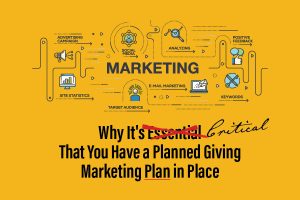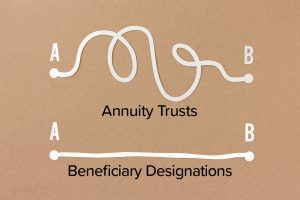
Yes. It’s Critical To Have a Planned Giving Marketing Plan in Place.
You have a planned giving program — that’s great! And you get those occasional gifts, and that’s great too. But you’re wondering if your donors know that you exist.
Home » Planned Giving Marketing » Page 23

You have a planned giving program — that’s great! And you get those occasional gifts, and that’s great too. But you’re wondering if your donors know that you exist.

You can’t believe how hard it is for people to be simple, how much they fear being simple. They worry that if they’re simple, people will think they’re simpleminded. In reality, of course, it’s just the reverse. (~ Jack Welch, CEO General Electric.)

What’s the big deal about planned giving anyway? When it comes to things we don’t understand, or may be intimidated by, there’s always a reason to avoid taking a closer …

The classic cry of the binge fundraiser is “Oops… gifts are slow to come in. I guess I’d better send out a mailing.” If you find yourself in the middle of a quiet spell, thinking that a few actions, a couple of phone calls and a mailing here and there will get things moving again, you need to rethink your strategy.

That canned “planned giving newsletter” you’re paying for is viewed by your recipients as a “death brochure” and is going right into the trash. Spend your money wisely. (By Tom Ahern)

I saw a blog post penned by another planned giving vendor. Its sole purpose: To trash the idea that fundraisers need a planned giving website. Very interesting …

Did you know that more than 90% of planned gifts are beneficiary designations? And by simply promoting beneficiary designations to your prospects, your organization will see its endowment grow by leaps and bounds. [Here’s a handy Beneficiary Designations Gift Planning Toolkit you can use.] Why? What makes this particular planned gift so attractive? It’s the simplicity. Giving a beneficiary designation is literally as easy as filling out a form. The form names the individuals and charities you want to support, and specifies the percentage of the assets you want each beneficiary to receive. They are very simple to give, easy to arrange, and usually do not require an attorney. So what’s the easiest way to market them? By mailing at least 4 postcards on beneficiary designations to your donors and prospects this year. Do not try to get creative with award-winning designs. Just concentrate on getting the word out. It doesn’t get any easier than that. Beneficiary designations can take multiple shapes, including: Cash Appreciated Securities/Investments Fund Accounts United States Savings Bonds Bank Accounts Jointly Held Accounts Life Insurance IRAs/Retirement Accounts CDs Any person who cares about your mission — rich or poor, educated or not — can easily make these kinds of gifts. And it won’t have any impact on their day-to-day cash flow! That’s why we like to call them “gifts anyone can make” or “gifts for the rest of us.” Again… By simply marketing Beneficiary Designations, you will see both your organization’s endowment and your career grow. With no fuss, no muss, and without any hassle! It’s the most ridiculously easy and blazingly fast way for you to get the word out to prospects about the easiest, most popular planned gifts. And they’re the easiest gifts for your organization to accept. By the way, before haphazardly developing any planned giving marketing tools, you should begin with a 12-Month Marketing Plan. This will be your road map to success. You should also learn how your basic planned gifts work (no matter what anyone says, you do not need to be a lawyer or an accountant). Read about gift planning vehicles. Categories: Giving, Planned Giving Marketing, Marketing Planned Giving

The face of philanthropy is changing: Researchers found that many donors want to talk with an advisor before they’ll even approach a nonprofit to discuss their intentions.

Two great quotes from Mario Andretti: “If everything seems under control you are not going fast enough.” and “Don’t look at the wall.”

What does wanting to meet (and marry) a rich guy have to do with planned giving? More than you think, and it all boils down to the meaning of the word “rich.” This puts “I want to meet a rich donor” in a whole new light.